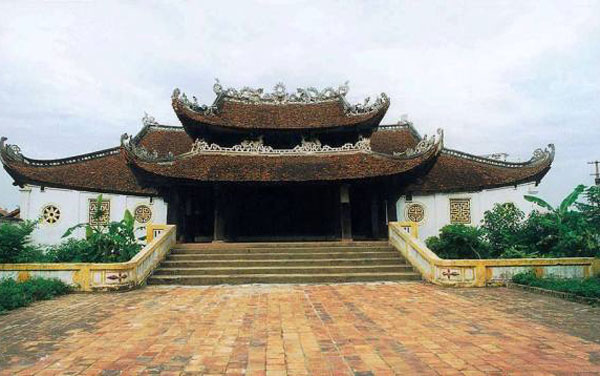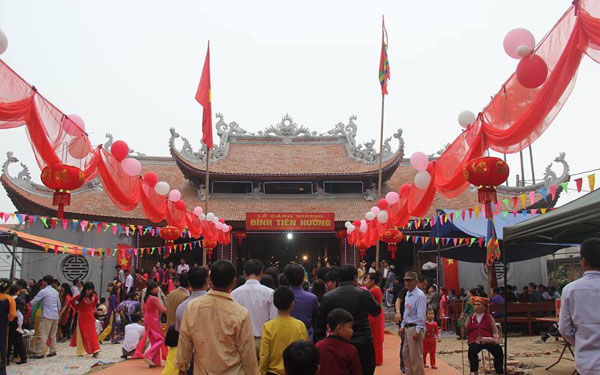Vinh Phuc is known for many scenic spots such as: Tam Dao, Xa Huong Lake, Dai Lai Lake… In addition, this place is also known for the historical site of Tam Canh communal house cluster. The communal house cluster is one of the few famous ancient communal houses remaining in the Northern region.
Where is Tam Canh communal house cluster?
The communal house cluster is located about 7km from Vinh Yen city. The cluster of relics known as the beautiful scenery of Vinh Yen is located along National Highway 2A. This place is about 50km from Hanoi. The communal house cluster includes 3 communal houses: Huong Canh, Ngoc Canh and Tien Huong. This is also the name of 3 villages in Huong Canh town, Binh Xuyen district, Vinh Phuc province.
Each village has its own communal house, but all worship 5 historical figures who were conferred “Gods”. That is Ngo Xuong Ngan, the eldest son of Ngo Quyen. Ngo Xuong Van is the second son of Ngo Quyen. Do Canh Thac was a general of Ngo Quyen. Ngo Xuong Van’s mother was Queen Mother Linh Quang and a female princess was named Princess Thi Tang.
The cluster of relics dates to the end of the 17th century and the beginning of the 18th century. The overall architectural plan of the three communal houses is arranged in the font “Vuong”. The architecture of this cluster of monuments is monumental with massive wood. Besides, the communal house cluster is also famous for sophisticated and sophisticated interior decoration carving stations.
If you come here in the early spring, you can also enjoy some special traditional festivals. The traditional games here are still preserved intact, crowded every spring. There are games such as: Pull Song, Word Puzzle…
Huong Canh communal house belongs to Tam Canh communal house cluster
All the extras like the column throats are sculpted into unique works of art. The pliers are criss-crossed to the hand’s depth. Featured with evenly curved markings. The diaphragm heads, arm swings are carved into the shape of stout elephants. The image of elephants looks like they are carrying the roof of the house together.

Huong Canh Communal House with ancient architecture
In the communal house, there are a total of 19 large and small carvings. The paintings are divided into 6 large panels in the communal house. This is a miniature simulation of the village festival. The image has partly reflected the unique activities of the people of the Le Trung Hung period.
Dinh Ngoc Canh
The content and carving art of Ngoc Canh communal house is also different from Huong Canh communal house. If Huong’s communal house describes a lot about village festivals and bustling games, Ngoc Canh’s communal house is more about describing the image of hard workers. Simultaneously simulating everyday pleasures in the countryside.

Dinh Ngoc Canh is silent between heaven and earth
The communal house is designed with a tight and balanced layout. Dinh Ngoc Canh is a perfect work, containing many profound ideological contents. The most distinctive feature in the architecture is the painting “building a mast”. This work is carved on a sub-column in the side compartment. “Building a Mast” depicts a scene of a sailor building a sailboat.
Tien Huong communal house in Tam Canh communal house cluster
Tien Huong Communal House has a feature that rarely describes the scene of human activities. Most of the carved scenes are natural scenes and objects of worship. These can be mentioned as: turtles, phoenixes, glasses, lotuses…
Dragon images are popularly depicted and in many different poses: pole-rolling dragon, climbing dragon, fish-turning-dragon…
The most prominent carving is the hammock door. In the communal house, there are two doors inside and outside, each time there are three doorways. The doors are decorated with seven layers of beautiful dragon fish. Each dragon has a length of 1.5m bending all the way to the height of the door. The fish’s head at the end has a curved upward direction to observe the entire body that has turned into a dragon.
Three ornate eight-story inner doorways. Each floor is a complete dragon all the way through the door. The dragon’s body is fringed with the shapes of marks. The dragon’s head is below, but its head is raised, its mouth is open, and its eyes are black and white. The two columns in the middle of the communal house are carved with a pair of large dragons wrapped tightly in the columns. In all six hammock doorways are more than a hundred dragons. The dragons are all lying in the same position parallel to each other, the background is a forest of macaques that looks very superficial.

The festival is held at the communal house
Above the hammock door is a windscreen that connects to the ceiling of the communal house. It is decorated with dragons adoring the sun. The image of the phoenix has the word ‘shou’ and the four letters of the great letter ‘sacred palace’. The dragons around the windboard are all gilded with sparkling, brilliant, Asian-styled gold.
Tam Canh communal house cluster is a famous historical relic of Vinh Phuc province. If you are a lover, want to learn about national history, this is a great destination for you!
Source: Collected internet.